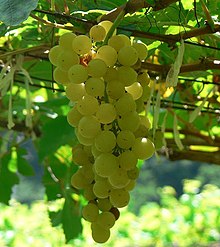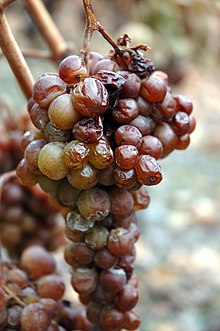
Cabernet Franc is one of the major black grape varieties worldwide. It is principally grown for blending with Cabernet Sauvignon and Merlot in the Bordeaux style, but can also be vinified alone, as in the Loire's Chinon. In addition to being used in blends and produced as a varietal in Canada, the United States and Argentina, it is sometimes made into ice wine in those regions.

Chenin blanc is a white wine grape variety from the Loire Valley of France. Its high acidity means it can be used to make varieties from sparkling wines to well-balanced dessert wines, although it can produce very bland, neutral wines if the vine's natural vigor is not controlled. Outside the Loire, it is found in most of the New World wine regions; it is the most widely planted variety in South Africa, where it was historically also known as Steen. The grape may have been one of the first to be grown in South Africa by Jan van Riebeeck in 1655, or it may have come to that country with Huguenots fleeing France after the revocation of the Edict of Nantes in 1685. Chenin blanc was often misidentified in Australia, as well, so tracing its early history in the country is not easy. It may have been introduced in James Busby's collection of 1832, but C. Waterhouse was growing Steen at Highercombe in Houghton, South Australia, by 1862.

A rosé is a type of wine that incorporates some of the color from the grape skins, but not enough to qualify it as a red wine. It may be the oldest known type of wine, as it is the most straightforward to make with the skin contact method. The pink color can range from a pale "onionskin" orange to a vivid near-purple, depending on the grape varieties used and winemaking techniques. Usually, the wine is labelled rosé in French, Portuguese, and English-speaking countries, rosado in Spanish, or rosato in Italian.

Muscadet is a French white wine. It is made at the western end of the Loire Valley, near the city of Nantes in the Pays de la Loire region. It is made from the Melon de Bourgogne grape, often referred to simply as melon. While most appellation d'origine contrôlée wines are named after their growing region, or in Alsace after their variety, the name Muscadet refers to an alleged characteristic of the wine produced by the melon grape variety: vin qui a un goût musqué. However, according to wine expert Tom Stevenson, Muscadet wines do not have much, if any, muskiness or Muscat-like flavors or aromas.

French wine is produced all throughout France, in quantities between 50 and 60 million hectolitres per year, or 7–8 billion bottles. France is one of the largest wine producers in the world, along with Spanish, Chinese, Italian, and American wine-producing regions. French wine traces its history to the 6th century BCE, with many of France's regions dating their wine-making history to Roman times. The wines produced range from expensive wines sold internationally to modest wines usually only seen within France such as the Margnat wines of the post-war period.

Vouvray is a French wine region in the Loire Valley located in the Touraine district just east of the city of Tours in the commune of Vouvray. The Appellation d'origine contrôlée (AOC) is dedicated almost exclusively to Chenin blanc; the obscure and minor grape Arbois is permitted but rarely used.

Grolleau, or Grolleau noir, is a red French wine grape variety that is grown primarily in the Loire Valley of France. The name is derived from the French word grolle, meaning "crow", and is said to reflect the deep black berries of the Grolleau vine. It is most commonly made into rosé wine, particularly in the Anjou region. Grolleau wines tend to have a low alcohol content and relatively high acidity.
Pineau d'Aunis is a red French wine grape variety that is grown primarily in the Loire Valley around Anjou and Touraine.
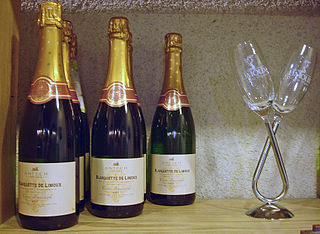
Limoux wine is produced around the city of Limoux in Languedoc in southwestern France. Limoux wine is produced under four Appellation d'origine contrôlée (AOC) designations: Blanquette de Limoux, Blanquette méthode ancestrale, Crémant de Limoux and Limoux, the first three of which are sparkling wines and dominate the production around Limoux. The main grape of the region is the Mauzac, locally known as Blanquette, followed by Chardonnay and Chenin blanc. In 2005, the Limoux AOC was created to include red wine production consisting of mostly Merlot. Wine historians believe that the world's first sparkling wine was produced in this region in 1531, by the monks at the abbey in Saint-Hilaire.
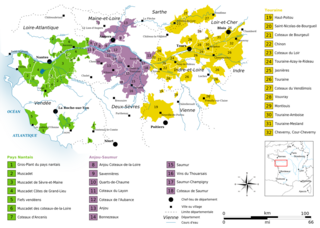
Saint-Nicolas-de-Bourgueil is a French wine Appellation d'origine contrôlée (AOC) in the Loire valley on the right bank of the river Loire. The AOC was created by a decree on July 31, 1937, covering about 800 hectares in the commune of Saint-Nicolas-de-Bourgueil in the département of Indre-et-Loire.

The wine regions of Bordeaux in France are a large number of wine growing areas, differing widely in size and sometimes overlapping, which lie within the overarching wine region of Bordeaux, centred on the city of Bordeaux and covering the whole area of the Gironde department of Aquitaine.

The Loire Valley wine region includes the French wine regions situated along the river Loire from the Muscadet region near the city of Nantes on the Atlantic coast to the region of Sancerre and Pouilly-Fumé just southeast of the city of Orléans in north central France. In between are the regions of Anjou wine, Saumur, Bourgueil, Chinon, and Vouvray. The Loire Valley itself follows the river through the Loire department to the river's origins in the Cévennes but the majority of the wine production takes place in the regions noted above. The area includes 87 appellations under the Appellation d'origine contrôlée (AOC) and Indication Géographique Protégée (IGP) systems.

In the Bordeaux wine region there are seven regional Appellations d'origine contrôlée (AOCs) that may be used throughout the Gironde department. These are Bordeaux Rouge AOC, Bordeaux Supérieur Rouge, Bordeaux Clairet, Bordeaux Rosé, Bordeaux Blanc, a dry white, Bordeaux Supérieur Blanc, a sweet white, and Crémant de Bordeaux, a sparkling méthode traditionnelle wine. The regional appellations together form the largest world-class wine vineyard, making up more than half of the production of the prestigious Bordeaux wine region, and representing more than 55% of all Bordeaux wines consumed in the world.

Provence (Provençal) wine comes from the French wine-producing region of Provence in southeast France. The Romans called the area provincia nostra, giving the region its name. Just south of the Alps, it was the first Roman province outside Italy.
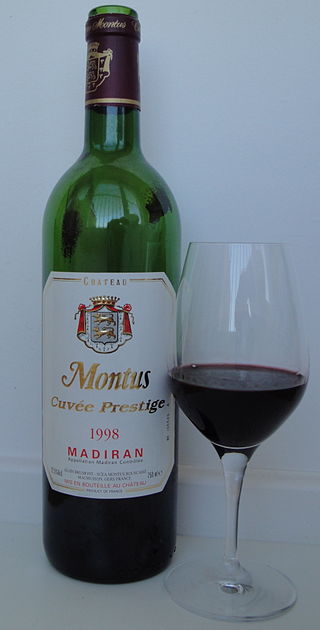
Madiran wine is produced around the village of Madiran in Gascony under three Appellations d'Origine Contrôlées (AOCs): Madiran for red wines and Pacherenc du Vic-Bilh and Pacherenc du Vic-Bilh Sec for white wines. The production area for Madiran wine is spread over three départments – Gers, Hautes-Pyrénées and Pyrénées-Atlantiques – and is a part of the South West France wine region. There are 1,300 hectares of Madiran vineyards.

Coteaux du Layon is an Appellation d'origine contrôlée (AOC) for sweet white wine in the Loire Valley wine region of France. Coteaux du Layon is situated in the Anjou district of the region, along the river Layon, which is a tributary of the Loire. Six of the villages (communes), namely Beaulieu-sur-Layon, Faye-d'Anjou, Rablay-sur-Layon, Rochefort-sur-Loire, Saint-Aubin-de-Luigné and Saint-Lambert-du-Lattay are allowed to add their name to that of the appellation. Usually, the "de" or "sur" part is dropped, to give names like Coteaux du Layon Beaulieu and Coteaux du Layon Saint-Aubin. Furthermore, two villages within the Coteaux du Layon area form their own respective AOC – Bonnezeaux and Chaume. Finally, a favoured enclave within Chaume is a separate AOC under the name Quarts de Chaume. For the geographically delimited AOCs, required grape maturity is higher and allowed yield is lower. The best vineyards are generally located on the north bank of the Layon, where they enjoy a good sun exposure on roughly south-facing slopes. Coteaux du Layon including its enclave appellations cover about 1,400 hectares in the early 2000s.

Savennières wine is a white wine, usually dry, produced from Chenin blanc around Savennières in the Loire Valley. The vineyards are situated on the north bank of the river Loire, in the Anjou-Saumur subregion.

Touraine is an Appellation d'Origine Contrôlée (AOC) in the Loire Valley wine region in France that produce dry white wines and red wines rich in tannins. The AOC status was awarded by a decree of December 24, 1939. The wine-growing area extends over 5,300 hectares departments of Indre-et-Loire, Indre and Loir-et-Cher and comprises a total of 70 communes and it is thus a "subregional" appellation covering the same area as a number of local AOCs.

The gros-plant-du-pays-nantais is an appellation d'origine contrôlée (AOC) wine produced mainly in the Loire-Atlantique department. It is a dry white wine made mainly from the folle-blanche grape variety. In 2008, it covered a surface area of 1,372 hectares in the Pays de la Loire region, mainly south of Nantes, in the Loire-Atlantique département, and extending into the Maine-et-Loire and Vendée départements. In 2010, with 79,380 hectolitres, it was France's leading premium wine by volume.



